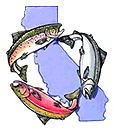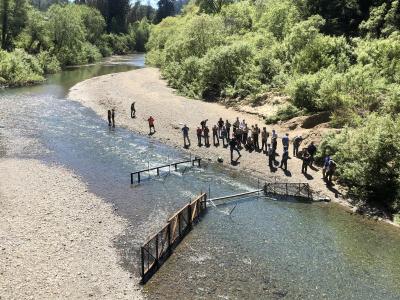Holding Space—Restoring Habitat and Making Room for Innovation
March 26 - 29, 2024
Assessing the Patient(s): Status, Trend, and Validation Monitoring to Understand the State of Salmon Populations and Recovery Efforts in Coastal California
29 March 2024
9:00am - 5:00pm
Session Coordinator: Gabe Rossi, UC Berkeley
~A community working toward salmon recovery without adequate monitoring is like a doctor treating a patient without adequate assessment.~
Salmon recovery is a massive enterprise. In California, hundreds of millions of dollars are spent on salmon and salmon habitat recovery efforts each year. And yet, only a small fraction of those funds are used to evaluate the state of our salmonid populations. For many populations and watersheds, there is limited monitoring – particularly for juvenile life stages. Thus, we are uncertain if, or to what extent, our actions are being effective. Validation monitoring for recovery efforts depends on a basic understanding of the status and trends of populations. Each type of monitoring is needed to effectively manage salmon. Today salmonid population monitoring in California is conducted by dedicated organizations including tribes, non-profits, watershed groups, county, state and federal agencies, and universities. However, there is a critical need for higher level visioning, coordination, communication, methodological consistency, and timely reporting to effectively evaluate the state of our salmon populations and to inform ongoing recovery efforts. How do we get there? Botkin et al. (2000) framed the fundamental question of validation monitoring for Columbia River basin: “If actions are taken in an attempt to improve the status of salmon populations…,what measurements are necessary, feasible, and practical to determine whether the actions are successful?” In this session we will ask that same question for our California coastal salmon streams. This session brought together monitoring practitioners working in watersheds across California. The coordinators and presenters highlighted ongoing monitoring efforts – both successes and challenges; talked about the most pressing monitoring needs in California; and considered novel methods that can advance our monitoring goals. In addition to the presentations, a panel of speakers addressed these questions and worked toward a convergent vision of what salmonid monitoring in California can and should be.
Salmon recovery is a massive enterprise. In California, hundreds of millions of dollars are spent on salmon and salmon habitat recovery efforts each year. And yet, only a small fraction of those funds are used to evaluate the state of our salmonid populations. For many populations and watersheds, there is limited monitoring – particularly for juvenile life stages. Thus, we are uncertain if, or to what extent, our actions are being effective. Validation monitoring for recovery efforts depends on a basic understanding of the status and trends of populations. Each type of monitoring is needed to effectively manage salmon. Today salmonid population monitoring in California is conducted by dedicated organizations including tribes, non-profits, watershed groups, county, state and federal agencies, and universities. However, there is a critical need for higher level visioning, coordination, communication, methodological consistency, and timely reporting to effectively evaluate the state of our salmon populations and to inform ongoing recovery efforts. How do we get there? Botkin et al. (2000) framed the fundamental question of validation monitoring for Columbia River basin: “If actions are taken in an attempt to improve the status of salmon populations…,what measurements are necessary, feasible, and practical to determine whether the actions are successful?” In this session we will ask that same question for our California coastal salmon streams. This session brought together monitoring practitioners working in watersheds across California. The coordinators and presenters highlighted ongoing monitoring efforts – both successes and challenges; talked about the most pressing monitoring needs in California; and considered novel methods that can advance our monitoring goals. In addition to the presentations, a panel of speakers addressed these questions and worked toward a convergent vision of what salmonid monitoring in California can and should be.
Sequential Monitoring to Inform Reintroduction and Restoration of Anadromous Salmonid Populations in Watersheds Along the California Coast, Tommy Williams, NOAA Fisheries
Leveraging a 25 Year Monitoring Program to Evaluate Restoration Actions in the Yolo Bypass Floodplain, Nicole Kwan, California Department of Water Resources
An Integrated Monitoring Approach to Support Salmonid Recovery in the Russian River Watershed, Mariska Obedzinski, California Sea Grant
Fifty Years of Juvenile Salmonid Monitoring in Lagunitas Creek and Why It’s Time to Try Something New, Eric Ettlinger, Marin Municipal Water District
Low Mainstem Survival of Juvenile Salmonids in Coastal California Rivers Impairs Recovery and Masks Survival Bottlenecks, Gabe Rossi, University of California, Berkeley; and Gregg Horton, Sonoma County Water Agency
Monitoring Adult Salmon and Steelhead Abundance in the Eel River Watershed and Future Monitoring Concepts to Inform Factors Limiting the Recovery of Salmonids in the Eel, David Kajtaniak, California Department of Fish and Wildlife
Juvenile Salmonid Spatial Structure Surveys as a Platform for Assessing Drought Effects and Informing Management Decisions on a Landscape-Scale, Chris Loomis, California Department of Fish and Wildlife
Implementing and Monitoring Lateral Connectivity for a Large Scale Salmonid Rearing Habitat Restoration Project on the Yuba River, Sam Diaz, cbec eco-engineering and Avery Scherer, Cramer Fish Sciences
Ocean Ranch, Episode II: Return of the Sculpin, Smelt, Shrimp, Stickleback…Oh and Salmon, Estuarine Monitoring Post-Restoration at Ocean Ranch in Wiya’t (Eel River), Marisa McGrew, Wiyot Tribe
Drought Refuge Monitoring in Selected Central California Coho Salmon (Oncorhynchus kisutch) Watersheds, Elizabeth Ruiz, California Department of Fish and Wildlife
Controlling Sacramento Pikeminnow in the South Fork Eel River to Benefit Native Salmon, Phil Georgakakos, University of California, Berkeley
Assessing the Outcomes of a Half Century of Hatchery Intervention for a Critically-Endangered Coho Population, Alexander Johanson, University of California, Davis
Collaborative Conservation of Ishyâat in a Spring-Run Chinook Salmon (Oncorhynchus tshawytscha) Stronghold: Results from the First Year, Amy Fingerle, University of California, Berkeley

